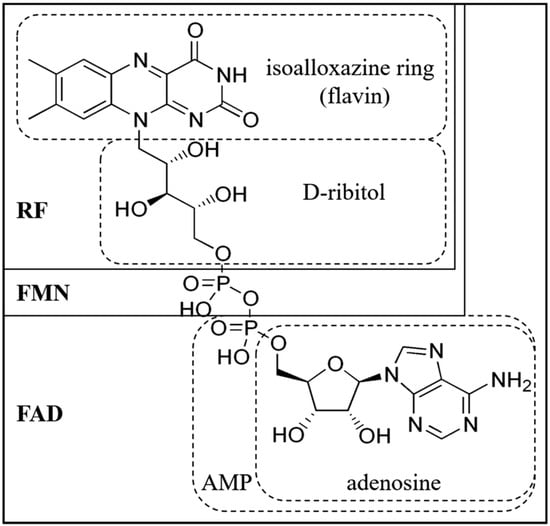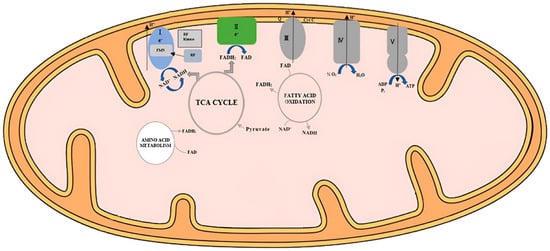4. Riboflavin and Poultry Growth
An important observation from the first half of the 20th century is that riboflavin was designated as the “growth-promoting vitamin G”
[69][70][71][72][73][74][90,91,92,93,94,95]. This recognition is rooted in riboflavin’s involvement in a multitude of physiological processes intricately linked to the overall growth performance of domestic fowl species. Within this complex web of biological interactions, vitamin B
2 significantly influences pivotal factors that contribute to poultry growth, including nutrient utilization, protein synthesis, and enzyme activity
[7][72][75][76][7,30,93,96].
The interrelation between vitamin B
2 and nutrient utilization constitutes a fundamental aspect in comprehending its influence on poultry growth. Riboflavin serves as a cofactor for enzymes engaged in the metabolic pathways responsible for the degradation of carbohydrates, lipids, and proteins
[10][77][10,97]. Through facilitation of these enzymatic reactions, riboflavin indirectly enhances the efficacy of nutrient breakdown and absorption within the avian gastrointestinal tract
[26]. This, in turn, culminates in a heightened extraction of energy and nutrients from the ingested feed, thereby furnishing the essential foundational components required for optimal growth. The amelioration in nutrient utilization serves as a principal catalyst underpinning the growth-promoting ramifications of riboflavin across diverse poultry species
[25][70][75][78][25,30,91,98].
The Tricarboxylic Acid cycle (TCA) holds pivotal significance in the growth of living organisms, as it induces energy production, furnishes foundational constituents, and upholds redox equilibrium
[79][99]. FAD and FADH
2, integral to the TCA cycle, assume a pivotal role by engaging in redox reactions that contribute to energy synthesis and streamlined growth processes
[80][100]. Dysfunction within this cycle or disruptions in FAD/FADH
2 participation can impede growth-associated pathways and cellular functionality.
Shifting focus beyond nutrient utilization, the significance of riboflavin in protein synthesis emerges as a pivotal factor in promoting poultry growth. The process of protein biosynthesis, fundamental to the development of muscles, tissues, and bodily structures in both mammals and avian species, involves riboflavin. Specifically, vitamin B
2 plays a role in the folding of newly synthesized proteins within the endoplasmic reticulum, facilitated by an FAD-dependent enzyme called endoplasmic reticulum oxidoreductase 1
[81][82][101,102]. Hypovitaminosis B
2 can potentially disrupt this protein folding process due to diminished flavoproteins and an imbalanced redox state, triggering a stress response within the endoplasmic reticulum
[82][102].
Empirical evidence supporting the influence of riboflavin on domestic fowl growth is substantial and compelling. Diverse experiments across various poultry species have been conducted to explore the impact of vitamin B
2 supplementation on growth performance
[4][5][8][13][17][25][69][70][71][72][73][74][78][83][4,5,8,13,17,25,33,90,91,92,93,94,95,98].
5. Oxidative Stress Defense
Oxidative stress, characterized by an imbalance between the production of reactive oxygen species (ROS) and cellular detoxification mechanisms, presents a significant challenge to domestic fowl health and productivity
[84][58]. Avian cells have developed an intricate defense network to counter this threat, with riboflavin emerging as a pivotal component in this system
[11]. Recent investigations have unveiled an additional dimension to riboflavin’s role—its function as a potent antioxidant within animal cells
[75][30]. This discovery underscores its critical contribution to ROS neutralization and cellular protection, rendering it indispensable in poultry’s defense against redox imbalance
[26].
The complex metabolic processes inherent to avian cells inevitably lead to the generation of ROS as natural by-products. While ROS serve important physiological roles, their excessive accumulation triggers oxidative stress, inducing damage to lipids, proteins, and nucleic acids
[85][119]. Such cellular damage disrupts vital functions, compromises immune responses, and fosters the onset of diverse poultry ailments
[84][58].
Central to riboflavin’s role as an antioxidant is its active involvement in the glutathione redox cycle. Glutathione, a robust tripeptide antioxidant, plays a pivotal role in defending against damage induced by ROS. Vitamin B
2 contributes to this cycle by facilitating the activity of glutathione reductase. This enzymatic action promotes the regeneration of reduced glutathione from its oxidized state, as detailed by Suwannasom et al.
[10].
The significance of riboflavin’s robust antioxidant capabilities becomes notably more conspicuous when contextualized within the contemporary landscape of poultry farming. Modern techniques of poultry production expose avian species to an assortment of stress-inducing factors, encompassing elevated temperatures, pathogenic microorganisms, and environmental pollutants. These factors collectively contribute to an exacerbation of oxidative stress conditions
[84][86][58,123].
6. Reproductive Performance and Hatchability
Reproductive performance and hatchability constitute pivotal determinants within the poultry industry, wielding substantial influence over egg production efficiency and the overall triumph of poultry farming
[87][127]. One elemental factor that has been extensively scrutinized in relation to these parameters is riboflavin. The impact of vitamin B
2 on reproductive variables such as egg production, egg quality, and hatchability has elicited considerable attention from both researchers and poultry producers
[11][12][26][88][89][90][91][92][93][11,12,26,56,109,118,128,129,130]. Through an array of studies, it has been unequivocally demonstrated that a dearth of riboflavin can exert a substantial impact on poultry reproductive success, carrying profound ramifications for both economic and bird welfare considerations.
Hatchability, a critical parameter in poultry farming, is significantly influenced by riboflavin status
[94][95][96][97][132,133,134,135]. In fact, hypovitaminosis B
2 emerges as one of the prevalent nutritional insufficiencies capable of influencing the hatching process
[98][136]. The various developmental stages of an embryo within an egg demand a consistent supply of nutrients and energy. Riboflavin’s role in cellular energy generation through its participation in the electron transport chain bears a direct connection to embryonic development and viability
[99][100][137,138]. A lack of riboflavin during incubation can lead to impaired growth and development of the embryo, ultimately resulting in reduced hatchability rates
[101][139].
Moreover, riboflavin’s impact on reproductive success can also be attributed to its involvement in cellular growth and differentiation. Vitamin B
2 plays a crucial role in maintaining the integrity of cell membranes through its participation in lipid metabolism and the regulation of oxidative stress
[11][82][102][11,102,145]. Riboflavin deficiency can disrupt cellular membrane structure and function, affecting the development and viability of reproductive cells
[102][145]. This disruption may potentially yield impaired follicle development, disrupted ovulation, and compromised sperm and oocyte quality, ultimately influencing hatchability rates.
7. Riboflavin Requirements for Poultry
The recommended dietary requirements for vitamin B
2 vary among different poultry species and at different stages of their production cycle, reflecting the dynamic nature of avian growth and development. In broiler chickens, for instance, riboflavin needs are influenced by their rapid growth during the fattening phase
[25]. This phase, characterized by rapid muscle and skeletal development, necessitates increased riboflavin intake, along with other essential vitamins, to support energy metabolism and tissue repair
[103][148]. Conversely, when considering laying hens during their peak egg production phase, distinct vitamin B
2 requirements emerge
[11][88][11,56].
Beyond species and production stages, riboflavin requirements are intricately tied to feed composition
[13]. The delicate interplay between vitamin B
2 and other nutrients underscores the importance of a balanced diet
[50][64]. Poor-quality feeds can hinder riboflavin absorption and utilization, leading to deficiencies despite adequate dietary levels. Additionally, stressors, drug usage, and disease challenges amplify avian metabolic demands, prompting heightened vitamin requirements
[51][35].
It is crucial to distinguish between vitamin B
2 requirement estimates and allowances as determined by scientific committees such as the National Academies of Sciences, Engineering, and Medicine
[104][149] (formerly known as the National Research Council), the Gesellschaft für Ernährungsphysiologie (GfE)
[105][150], and recommendations from poultry breeding companies like Aviagen, Cobb-Vantress, and Lohmann
[106][107][108][109][153,154,155,158]. Poultry producers often refer to both sources to strike a balance between scientific knowledge and the specific genetic potential of their flocks.
In contemporary times, there is a growing acknowledgment that the vitamin requirements for commercial poultry production may surpass the previously established levels for healthy birds in controlled research settings, as outlined by organizations like NASEM
[110][71]. Stress, infections, and illnesses can substantially elevate the vitamin needs of birds, factors that must be taken into account in real-world farming scenarios
[111][166].
Riboflavin’s involvement in cellular growth and repair mechanisms underscores its significance during the rapid growth phase of poultry. Skeletal development, a complex process of bone formation and remodeling, relies heavily on vitamin B
2-mediated energy transactions. As chicks develop their skeletal framework at a rapid pace, the mineralization process depends on the energy generated through riboflavin-supported metabolic pathways
[112][167]. This not only influences bone strength but also contributes to the overall structural robustness of growing birds. Hypovitaminosis B
2 can lead to an increase in deformed legs and poor mobility in broilers
[113][117]. Citrate, which comprises approximately 1.6% of bone content and about 80% of total body citrate residing in bones, plays a crucial role in bone stability, strength, and resistance to fracture
[114][168]. Riboflavin in its coenzyme form FAD is critical for the normal functioning of the citric acid cycle, which is presumed to be a key supplier of citrate for the bone’s apatite nanocrystal structure
[114][168]. This occurs through the prevention of citrate oxidation via the Krebs cycle in some bone cells, maximizing citrate accumulation
[114][168].
8. Conclusions
Riboflavin plays a crucial role in the field of poultry nutrition and health. Its diverse functions as a coenzyme in various metabolic reactions, particularly in redox reactions and energy metabolism, emphasize its indispensability in avian physiology. Vitamin B
2 significantly contributes to enhancing nutrient utilization, facilitating protein synthesis and folding, and promoting enzyme activity. These roles collectively support optimal growth and performance in domestic fowl. Moreover, the impact of riboflavin on reproductive parameters, such as egg production, egg quality, and hatchability, cannot be overstated. Its involvement in energy metabolism and antioxidant defense mechanisms directly influences the reproductive success of avian species, with far-reaching implications for both economic viability and animal welfare considerations.
Exploring riboflavin’s interactions with other essential nutrients, investigating the potential of riboflavin analogs as antimicrobial agents, and embracing advanced technologies like precision nutrition and nanotechnology for improved riboflavin delivery represent promising avenues for future research in poultry nutrition.


